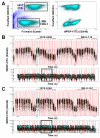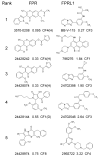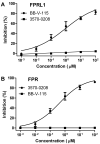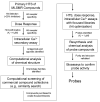Duplex high-throughput flow cytometry screen identifies two novel formylpeptide receptor family probes
- PMID: 18785269
- PMCID: PMC2645486
- DOI: 10.1002/cyto.a.20645
Duplex high-throughput flow cytometry screen identifies two novel formylpeptide receptor family probes
Abstract
Of recent, clinical interest have been two related human G-protein coupled receptors: formylpeptide receptor (FPR), linked to antibacterial inflammation and malignant glioma cell metastasis; and FPR like-1 (FPRL1), linked to chronic inflammation in systemic amyloidosis, Alzheimer's disease, and prion diseases. In association with the National Institutes of Health (NIH) Molecular Library Screening Network, we implemented a flow-cytometry-based high-throughput screening (HTS) approach for identifying selective small molecule FPR and FPRL1 ligands. The screening assay measured the ability of test compounds to competitively displace a high-affinity, fluorescein- labeled peptide ligand from FPR, FPRL1, or both. U937 cells expressing FPR and rat basophil leukemia (RBL) cells expressing FPRL1 were tested together in a "duplex" format. The U937 cells were color coded with red-fluorescent dye allowing their distinction during analysis. Compounds, cells, and fluorescent ligand were sequentially combined (no wash) in 15 microl assay volumes in 384-well plates. Throughput averaged approximately 11 min per plate to analyze approximately 4,000 cells ( approximately 2,000/receptor) in a 2 microl aspirate from each well. In primary single concentration HTS of 24,304 NIH Small Molecule Repository compounds, 253 resulted in inhibition >30% (181 for FPR, 72 for FPRL1) of which 40 had selective binding inhibition constants (K(i)) < or = 4 microM (34 for FPR and 6 for FPRL1). An additional 1,446 candidate compounds were selected by structure-activity-relationship analysis of the hits and screened to identify novel ligands for FPR (3570-0208, K(i) = 95 +/- 10 nM) and FPRL1 (BB-V-115, K(i) = 270 +/- 51 nM). Each was a selective antagonist in calcium response assays and the most potent small molecule antagonist reported for its respective receptor to date. The duplex assay format reduced assay time, minimized reagent requirements, and provided selectivity information at every screening stage, thus proving to be an efficient means to screen for selective receptor ligand probes.
2008 International Society for Advancement of Cytometry.
Figures
Similar articles
-
A novel fluorescent cross-reactive formylpeptide receptor/formylpeptide receptor-like 1 hexapeptide ligand.Cytometry A. 2009 Mar;75(3):264-70. doi: 10.1002/cyto.a.20670. Cytometry A. 2009. PMID: 19006074 Free PMC article.
-
The peptide Trp-Lys-Tyr-Met-Val-D-Met activates neutrophils through the formyl peptide receptor only when signaling through the formylpeptide receptor like 1 is blocked. A receptor switch with implications for signal transduction studies with inhibitors and receptor antagonists.Biochem Pharmacol. 2006 May 14;71(10):1488-96. doi: 10.1016/j.bcp.2006.02.010. Epub 2006 Mar 6. Biochem Pharmacol. 2006. PMID: 16549058
-
The non-steroidal anti-inflammatory drug piroxicam blocks ligand binding to the formyl peptide receptor but not the formyl peptide receptor like 1.Biochem Pharmacol. 2007 Oct 1;74(7):1050-6. doi: 10.1016/j.bcp.2007.06.049. Epub 2007 Jul 7. Biochem Pharmacol. 2007. PMID: 17692291
-
Discovery of selective probes and antagonists for G-protein-coupled receptors FPR/FPRL1 and GPR30.Curr Top Med Chem. 2009;9(13):1227-36. doi: 10.2174/156802609789753608. Curr Top Med Chem. 2009. PMID: 19807662 Free PMC article. Review.
-
A new insight into the role of "old" chemotactic peptide receptors FPR and FPRL1: down-regulation of chemokine receptors CCR5 and CXCR4.Forum (Genova). 1999 Oct-Dec;9(4):299-314. Forum (Genova). 1999. PMID: 10611407 Review.
Cited by
-
Spectral flow cytometry.Curr Protoc Cytom. 2013 Jan;Chapter 1:1.27.1-1.27.13. doi: 10.1002/0471142956.cy0127s63. Curr Protoc Cytom. 2013. PMID: 23292705 Free PMC article. Review.
-
The Formyl Peptide Receptors: Diversity of Ligands and Mechanism for Recognition.Molecules. 2017 Mar 13;22(3):455. doi: 10.3390/molecules22030455. Molecules. 2017. PMID: 28335409 Free PMC article. Review.
-
Selective Display of a Chemoattractant Agonist on Cancer Cells Activates the Formyl Peptide Receptor 1 on Immune Cells.Chembiochem. 2022 Apr 20;23(8):e202100521. doi: 10.1002/cbic.202100521. Epub 2022 Mar 9. Chembiochem. 2022. PMID: 35199442 Free PMC article.
-
Identification of novel small-molecule agonists for human formyl peptide receptors and pharmacophore models of their recognition.Mol Pharmacol. 2010 Feb;77(2):159-70. doi: 10.1124/mol.109.060673. Epub 2009 Nov 10. Mol Pharmacol. 2010. PMID: 19903830 Free PMC article.
-
A "No-Touch" Antibody-Staining Method of Adherent Cells for High-Throughput Flow Cytometry in 384-Well Microplate Format for Cell-Based Drug Library Screening.Cytometry A. 2020 Aug;97(8):845-851. doi: 10.1002/cyto.a.23956. Epub 2019 Dec 26. Cytometry A. 2020. PMID: 31876358 Free PMC article.
References
-
- Le Y, Murphy PM, Wang JM. Formyl-peptide receptors revisited. Trends Immunol. 2002;23(11):541–8. - PubMed
-
- Oppenheim JJ, Zachariae CO, Mukaida N, Matsushima K. Properties of the novel proinflammatory supergene “intercrine” cytokine family. Annu Rev Immunol. 1991;9:617–48. - PubMed
-
- Murphy PM. The N-formylpeptide chemotactic receptor. In: Horuk R, editor. Chemoattractant ligands and their receptors. CRC Press; Boca Raton, FL: 1996. pp. 269–299.
-
- Le Y, Oppenheim JJ, Wang JM. Pleiotropic roles of formyl peptide receptors. Cytokine Growth Factor Rev. 2001;12(1):91–105. - PubMed
-
- Murphy PM. The molecular biology of leukocyte chemoattractant receptors. Annu Rev Immunol. 1994;12:593–633. - PubMed
Publication types
MeSH terms
Substances
Grants and funding
LinkOut - more resources
Full Text Sources
Other Literature Sources








